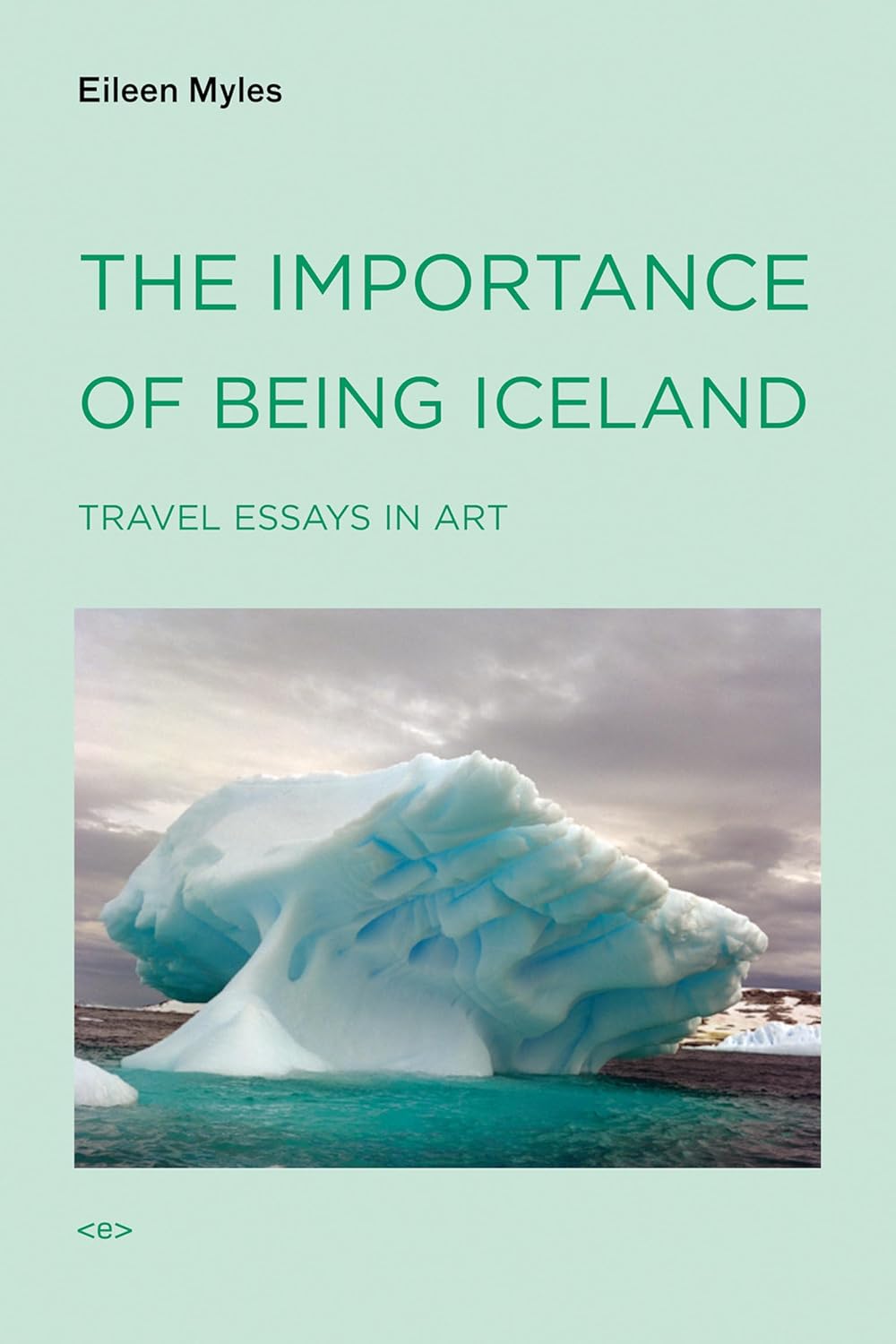Review of The Importance of Being Iceland: Travel Essays in Art by Eileen Myles

The Importance of Being Iceland: Travel Essays in Art
Eileen Myles
Semiotext(e), 2009, 368 pages
$18.95
Reviewed by Pippin Lapish
My Date with Eileen Myles
My girlfriend Sascha and I are in Brooklyn. Our night out begins at a tattoo parlor offering fifty dollar flash designs. I think Sascha wants a cross on the back of her neck, or maybe a smattering of stars on her hip descending into the delta of her crotch, or “mom” written inside a
pierced heart on her shoulder. I’m not sure, but all of her ideas translate tradition into the language of youth.
We walk into the shop and the poseur vibe is suffocating. The music is bad and too loud, the lights are too bright. It’s a bad idea to get tattooed somewhere so transparently and terminally uncool. So we leave. We both operate via reflexive aesthetic judgements.
On our way out, we pass a bookstore. I duck in automatically and wordlessly. It became a game for me to sniff out the good titles, to trim my vision into the pattern of spines. And then I won the game: I found a book I’ve been looking for. The Importance of Being Iceland: Travel Essays in Art by Eileen Myles.
The title is nonsensical. When you’re Eileen Myles, the title of your book doesn’t have to make sense, because you’re a hotshot. The book is a collection of previously unpublished essays, interviews, and blog posts, the dregs of a career. It’s a little hard to find, which is why I hadn’t already read it. Iceland lived in my saved for later list on Amazon, but buying from Amazon always feels desperate and cheap, like winning by default. Finding it in the wild, especially by accident, was triumphant. I had made the Big Catch, the winning kill. The book isn’t one of Myles’ pithy, slimmer volumes either. It looks like a textbook, thick and turquoise, with a photograph of an iceberg on the cover. The title is in all caps, and the Semiotext(e) logo announces the book’s verbose obscurity. It’s not bestseller or cult-classic material: it’s for the serious, rabid fans of Myles, those pitiful fanatics who lap up their every word.
GOD HATES BAGS, at least in New York, so I was stuck carrying the book around all night. It became a third wheel. Sascha had mapped our night out:
1. Get a tattoo
2. Get sushi
3. Ride back to Manhattan for a haunted house
4. Go to sex shop for a new cock
Our first order of business was an unceremonious yet total failure. The bookstore was shoved right between items one and two, imperceptibly inserted by me. It was a pound where I picked up a new pet, so Sascha was rightfully endeared and a little annoyed at my impulsivity. Iceland was a parrot occasionally chiming in. A newfound object of my attention and affections.
At the sushi restaurant, the book occupied its own little corner of the table, except for the moments I picked it up and dragged my finger along the pages. A few times, I committed a grave vulgarity: I cracked the book open and read a few lines at the table. Sascha stared at me as my head lowered and I squinted in the dim light. My attention was caught by a line: “. . .you are breaking the code of the working class by aiming to be a big cheese” (14). “Ha, Sascha, listen to this!” But then I saw her stony expression and. . . nevermind.
Reading Eileen Myles is the experience of discovering language. Like, “Oh what does this button do” and then you find out. Myles handles words with both reverence and a deeply personal sense of play. Puttering around in language but then holding specimens up to the light.
Sometimes I decide that text by Eileen Myles is my property. I just think “Yeah, you’re coming home with me,” and then it doesn’t go away. Eileen Myles’ prose is loyal. They write a lot about dogs and their writing seems to have a canine sort of personality. Meaty, heaving and drooling.
Eileen Myles treats all subject matter with the same weight. Every observation, object, or feeling is described with Myles’ signature certainty, so it all gets blown up onto this cosmic emotional scale. Everything, from the pain of losing their father to the creak of a wooden bed frame, is handled with the same odd mixture of intensity and flippancy. In Iceland, there’s an essay about working class speech. Myles says: “I think the part of working class speech that I’m aiming at today. . . is this willingness to throw the words away, to let the situation speak” (17-18). Myles really gives objects a chance, and a voice. Reading Eileen Myles has the mythic futility of emptying and filling a lake in equal parts. I am talking about Myles’ measuredness, their evenness, or their fairness. It’s all nice and balanced in Myles’ work. Not flat nor mathematical, just outstretched, like a palm or a clearing. Real open. You can step right inside.
After the sushi we were back on the L train, returning to Manhattan for the climax of the night, the haunted house.
When Sascha tells me stories about Los Angeles I have to manually paste the idea of heat on top of the scene. Heat and fame are two elements of Los Angeles that one grows immune to. The Midwest breeds loners, but she always felt like one part of something bigger, a conduit to a world that’s always churning and producing. She’s four foot eleven and beautiful in an untroubled way, which means she fits in everywhere. She’s a letter shook loose from the morning paper, always ready to burst into a headline. She’s kinetic—a live wire, a turning point. Iceland says “. . .it’s so American to think you can figure it out alone. With a little help from your famous friend” (160).
At a certain point in the haunted house, an actress dressed in a white slip with black hair over her eyes started breathing in my ear. In my terror, I shoved Iceland over my face, like a child with his blanket. I started thinking of the book as my exit out of the constructed nightmare, a little self-contained cell of the outside world. It was funny to see Eileen Myles’ name in a sudden red glint, bringing me, momentarily, out of the illusion. Fitting, somehow. Like Iceland is a break room in hell where the demons can go drink coffee out of styrofoam cups before heading back to work. Iceland says it’s like “. . .hand painted Goth, I mean S-C-A-R-Y, everything is ‘kid,’ and for one cool weird moment (well, nine minutes) we are all totally free” (311). That’s the great thing about haunted houses. Sort of like in a book, you’re not responsible for your actions inside a haunted house. You can scream and piss and fall on the floor and no one’s allowed to fault you. Iceland and haunted houses exist in this identical, egalitarian emotional sense, like you can get away with anything so you try everything.
One thing about Eileen Myles is that they never explain anything. There are no extended metaphors in Myles’ work. Everything is up front, bare, and laid out. They’re a real take it or leave it kind of author. Author is derived from the Latin augere, meaning to originate, which is where we get authority. So Myles is well within their etymological right to make no sense. In their book Afterglow they say, “The English language is extremely boaty.” And that totally deranged thought strikes me as incredibly correct. Because Myles doesn’t dither or wring their hands or worry, for an instant, about being understood. Their writing is governed by their intrinsic and inalienable authority, the writer’s birthright. They’re unreliable. Their writing is shaped like the slump of a shrugging shoulder or the contours of a dismissive hand. In Iceland they say, “Camera means room in Italian. No stanza does. Maybe it’s Spanish. Anyhow, I feel like a camera which is not” (320). Overall, Myles doesn’t know what they’re talking about. They just put it out there and middlemen, sifters, and interventionists like me handle the rest. They throw the meaning outside the parameters of the page, like the words are in the book, but the message is elsewhere.
Myles’ writing is a lot like a tin roof. Rippled shelter. Either hot to the touch or cool. Flimsy, but who would fuck with a tin roof? Even nature seems to spare it out of pity. There’s something scrappy and twee about it. Always an A for effort.
Myles flits between personas. Sometimes they’re a refined art critic and sometimes they’re shaking their fist at a cloud. They’re flighty and gimcrack. They mostly punch up. They’re assured and aloof but grubby, somehow both hardworking and bohemian. I picture their books coming together like a barn raising, but a barn raising that happens in a dream, so no one really breaks a sweat.
After the haunted house, we keep moving, still working off the adrenaline. Iceland says “You don’t want to be scared. You want to be excited, ennobled, teased alive.” “Heh, Sascha, listen to”—two eyes, recently recovered from terror and newly adjusted to the dark, shoot toward me—“nevermind.”
We walk to our favorite sex shop. Five inches is no longer cutting it. It’s an easy fix. It’s weird to browse for a prosthesis, but it’s funny to think that I can upgrade an organ. Is it a humiliation or a privilege? It’s just funny. Iceland says, “I see the pussy on the tip of a dick. A fat little smiley face” (304). A dildo’s pronouns would be ha/ha.
I pick out the strap. I walk over to Sascha, who’s flipping through the porno magazines. We pick out two issues from 2007. Later that night, we go through them and rip out the ugly girls.
The new strap is sixty dollars. I try not to imagine fucking her with sixty dollars. Iceland says “It seemed to me to be on the order of a lesbian ripple or chip.” Right: like a crinkly fistful of bills. I think about Marx’s idea of commodity fetishism as it pertains to my cock—oh, sorry. Sascha hates that word. Instead, she calls it a “worthy investment,” which makes me imagine it increasing in value, like my boner is a graph of an improving economy.
With my girlfriend, my newly buzzed hair, my leather jacket, a book by Eileen Myles, two porno magazines, and strap in a black plastic bag, I could feel my gayness literally hanging off of me. Iceland talks about “little girls hawking lesbianism. . . on a 40s street corner like they knew they had something cooler than lemonade” (66). I felt like the biggest dyke in the world, which is to say, a king. There’s not a more kingly feeling than your girlfriend being a little bit mad at you.
Sometimes I have these thoughts or experiences where I think to myself, “That’s an Eileen Myles moment.” Like when Sascha said to me, “They just don’t make tour buses like they used to.” And that statement feels like a joke, but there’s a vaguely sad plea for reflection buried right in there. That’s Eileen Myles’ formula: an acute yet superfluous observation with a twist of painful honesty.
Laying in bed that night, when Iceland’s been put away and the cock proved its worth, I tell Sascha why I like Eileen Myles so much. I told her about this one time, when I was reading Inferno, and they described the clit as a ‘spud.’ That’s the exact moment I realized just what you could do with language. Sascha cringed and said, “Eileen Myles should be tried for their crimes against my imagination.” I replied, “Be careful what you say; it’s gonna end up in the essay.”
Pippin Lapish is a writer from Michigan. Her work has previously appeared in Denver Quarterly, Gryllus Magazine, 11½ Journal, and Narrative Magazine. Her first poetry book, The Contrarian, is forthcoming from Hobby Horse Press. She lives in New York City.
"Empowerment comes from ideas."
― Charlene Carruthers
"Your silence will not protect you."
— Tourmaline
"Gender is the poetry each of us makes out of the language we are taught."
— Leila Raven


